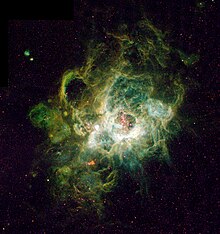astro.wikisort.org - Galaxy
NGC 604 is an H II region inside the Triangulum Galaxy. It was discovered by William Herschel on September 11, 1784. It is among the largest H II regions in the Local Group of galaxies; at the galaxy's estimated distance of 2.7 million light-years, its longest diameter is roughly 1,520 light years (~460 parsecs), over 40 times the size of the visible portion of the Orion Nebula. It is over 6,300 times more luminous than the Orion Nebula, and if it were at the same distance it would outshine Venus. Its gas is ionized by a cluster of massive stars at its center[4] with 200 stars of spectral type O and WR, a mass of 105 solar masses, and an age of 3.5 million years;[2] however, unlike the Large Magellanic Cloud's Tarantula Nebula central cluster (R136), NGC 604's one is much less compact and more similar to a large stellar association.[5]
| Emission nebula | |
|---|---|
| H II region | |
 | |
| Observation data: J2000 epoch | |
| Right ascension | 01h 34m 33.2s[1] |
| Declination | +30° 47′ 06″[1] |
| Distance | 2,700,000 ly (840,000[2] pc) |
| Apparent magnitude (V) | +14.0[1] |
| Apparent dimensions (V) | 1′.93 x 1′.2 arcmins[1] |
| Constellation | Triangulum |
| Physical characteristics | |
| Radius | 760[3] ly |
| Absolute magnitude (V) | -13.8 |
| Notable features | massive H II region 3.5 million years old[2] |
See also
References
- "NASA/IPAC Extragalactic Database". Results for NGC 604. Retrieved 2006-09-03.
- Barba, Rodolfo (2004). "An in-depth analysis of a prototypical giant H II region: NGC 604". HST Proposal ID #10419: 10419. Bibcode:2004hst..prop10419B.
- distance × sin( diameter_angle / 2 ) = 760 ly. radius
- Nemiroff, R.; Bonnell, J., eds. (2 November 2002). "NGC 604: Giant Stellar Nursery". Astronomy Picture of the Day. NASA.
- Maíz-Apellániz, J.; Pérez, E.; Mas-Hesse, J. M. (2004). "NGC 604, the Scaled OB Association (SOBA) Prototype. I. Spatial Distribution of the Different Gas Phases and Attenuation by Dust". The Astronomical Journal. 128 (3): 1196–1218. arXiv:astro-ph/0406130. Bibcode:2004AJ....128.1196M. doi:10.1086/422925.
- Some data in the table was updated from Sue French's column "Deep-sky Wonders", in the January 2006 issue of Sky & Telescope, p. 83.
External links
| Wikimedia Commons has media related to NGC 604. |
- Nebula NGC 604 @ SEDS Messier pages
- NASA Astronomy Picture of the Day: NGC 604 (16 August 1996)
- NASA Astronomy Picture of the Day: NGC 604: Giant Stellar Nursery (11 December 2012)
На других языках
[de] NGC 604
NGC 604 ist ein H-II-Gebiet in der Galaxie Messier 33 im Sternbild Dreieck am nördlichen Fixsternhimmel. Es hat eine Winkelausdehnung von etwa 1,95′ × 1,95′ und wurde am 11. September 1784 vom deutsch-britischen Astronomen Wilhelm Herschel entdeckt. Die Bezeichnung ergibt sich aus dem Eintrag des Objektes in dem in den 1880er Jahren zusammengestellten New General Catalogue. NGC 604 ist eines der größten bekannten H-II-Gebiete.- [en] NGC 604
[es] NGC 604
NGC 604 es una Nebulosa situada en la galaxia del Triángulo (M33), a una distancia de 850 kilopársecs de nuestra galaxia. Fue descubierta por William Herschel el 11 de septiembre de 1784.[ru] NGC 604
NGC 604 является областью H II в Галактике Треугольника. Была открыта Уильямом Гершелем 11 сентября 1784 года. Это один из крупнейших H II регионов в Местной группе галактик. При оцениваемом расстоянии до галактики в 2.7 млн св. лет, её наибольший размер составляет около 1500 св. лет (460 пк), что более чем в 40 раз превышает размер видимой части Туманности Ориона. Её светимость в 6300 раз больше светимости Туманности Ориона, и если бы она находилась на таком же расстоянии, то затмила бы Венеру. Как и во всех эмиссионных туманностях, газ ионизируется скоплением массивных звёзд в центре.Другой контент может иметь иную лицензию. Перед использованием материалов сайта WikiSort.org внимательно изучите правила лицензирования конкретных элементов наполнения сайта.
WikiSort.org - проект по пересортировке и дополнению контента Википедии
